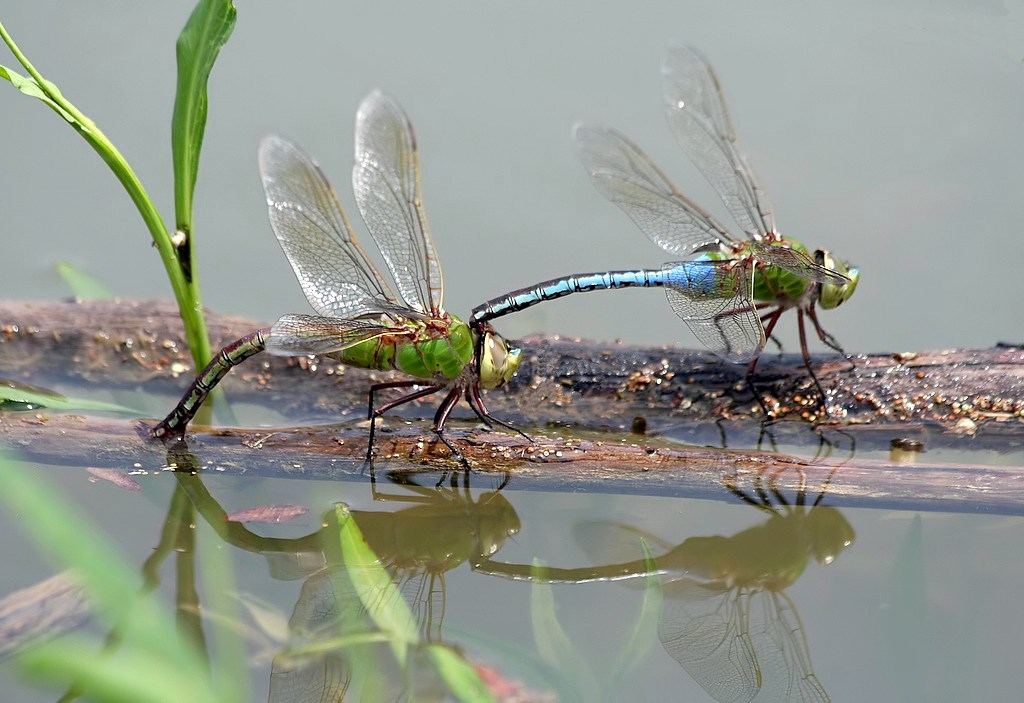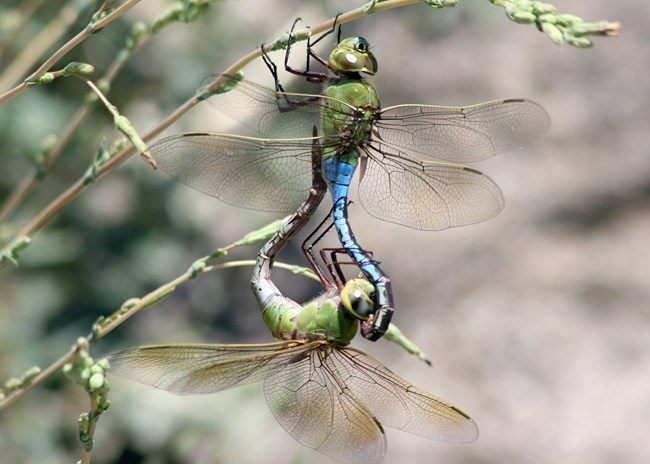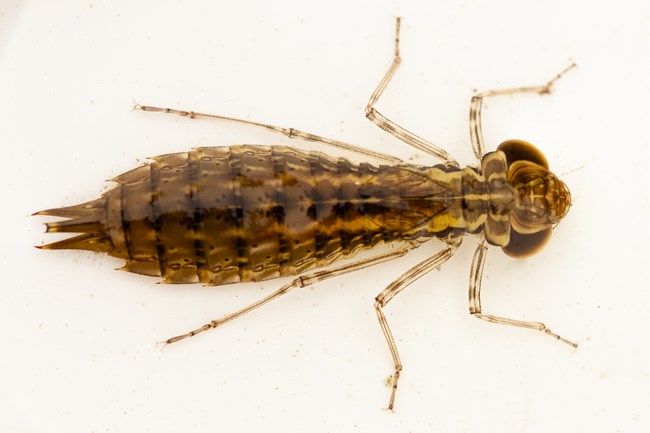Last updated: October 31, 2022
Article
Common Green Darner

Ken Slade, Creative Commons License 2.0. Source: Flickr.
General Description
Large-eyed and large-bodied, the common green darner (Anax junius) dragonfly is a brilliantly colored member of the Aeshnidae (darner) family, common in the Pacific Northwest and in much of North America. Adults have long abdomens (68–78 mm; 2.6–3 in) and a 9–10 cm (3.5–4 in) wingspan. Their large eyes, set in a greenish-olive head, and their solid green thorax (mid-section) help with identification. The male’s black abdomen has bright blue markings, unlike the duller, more brownish-orange abdomen of the female. The female’s color, however, can vary considerably—even approaching the male’s bright blue. Larvae of the common green darner are aquatic, lacking wings (though they do have small wing pads that grow with each molt) and living underwater in a very different, streamlined body form.
Dragonflies and damselflies compose the insect order, Odonata, named for toothlike ridges on their jaws. (Damselflies are smaller, more slender, and, with some exceptions, rest their wings vertically when perched.)
Habitat and Distribution
Dragonflies needs water to reproduce. In summer, the common green darner buzzes around warm, still water, such as lakes, ponds, wetlands, marshes, and backwater areas of slow streams throughout North America. Nonbreeding common green darners may forage anywhere they can find prey, including dry areas and outside of North America.
Behavior and Diet
Common green darners are “hawkers,” catching tiny flies, leafhoppers, beetles, and even smaller odonates on the wing as they fly rapidly over open water or along shorelines. When still, darners hang from vegetation by their long legs, rather than perching upright.
Dragonfly larvae, called nymphs or naiads, are also predators of the aquatic world, where they spend most of their lives before metamorphosing into winged, terrestrial adults. A spring-loaded labium (like a lower lip) grabs prey and pulls it back into mandibles. Because the rectum also contains the gills for “breathing,” it can forcibly expel the water it is drawing in and out for breathing to launch the fast attack!
Unlike many dragonflies, some common green darner populations migrate. They have been observed flying south along the Oregon coast in late Sep–Oct, sometimes in swarms of mixed dragonfly species—a banquet for hungry birds, such as purple martins, Swainson’s hawks, and merlins.
Precision flight is a dragonfly superpower. Because each wing is powered separately, dragonflies zip forward and backward, up and down, side to side, and hover with ease. This maneuverability undoubtedly helps them to hunt and to evade would-be predators, such as birds, spiders, frogs, fish, and lizards.

David A. Hofmann, Creative Commons license 2.0. Source: Flickr.
Reproduction
In summer, males fly low and fast over wet areas and along shorelines in search of females. Mating happens in the “mating wheel” position, connecting the tip of the male’s abdomen with the female’s head and the female’s reproductive organ with sperm on the male’s abdomen. They may fly around in this position for several minutes. The female then disconnects her abdomen but stays connected to the male in “tandem.” While still in tandem (in theory so the male can prevent other males from mating with her—“contact guarding”), the female inserts batches of hundreds of eggs into decaying plant material in the water with a sharp ovipositor—a tubular organ holding the eggs.

Douglas Mills, Creative Commons License 2.0.
Eggs hatch after about a week into tiny aquatic larvae that may molt up to a dozen times into increasingly larger bodies (instars). The last larval instar emerges from the water, breathes air (!), attaches to vegetation, and begins metamorphosis. A winged dragonfly emerges from a crack in the exoskeleton (now called the exuvia), pumping fluid into its new body and wings to expand and stiffen them. The immature dragonfly is called a teneral and is highly vulnerable to predation before its body is fully stiffened, colored, and functional. Depending on climate and migratory status, adults live for a few weeks to a month.
Fun Facts
-
“Darner” is a folk name for this type of dragonfly for its likeness to a darning needle.
-
This dragonfly’s compound eyes have 30,000+ simple eyes (ommatidia), can see almost 360° around, and can see UV light.
-
Dragonflies are ancient—some of the earliest winged insects. Fossils date back over 300 million years ago, before the dinosaurs.
Where to See
The common green darner may occur in wet areas of any Klamath Network park, or away from water during migration.
Learn More
https://ucmp.berkeley.edu/arthropoda/uniramia/odonatoida.html
Dragonfly citizen science
https://www.odonatacentral.org/#/

Download a pdf of this article.
Prepared by Sonya Daw
NPS Klamath Inventory & Monitoring Network
Southern Oregon University
1250 Siskiyou Blvd
Ashland, OR 97520
Featured Creature Edition: October 2022
Thumbnail image credit: Ken Slade, Creative Commons License 2.0. Source: Flickr.
